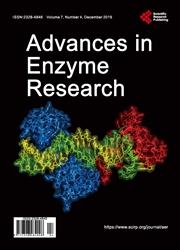Optimization of Growth Conditions to Identify the Superior Bacillus Strain Which Produce High Yield of Thermostable Alpha Amylase
引用次数: 1
Abstract
Thermostable α-amylases hold a very important place in commercial industrial applications in Sri Lanka. Therefore, the main aim of this study was to identify superior Bacillus strain and optimize growth conditions that could yield high α-amylase production. Three Bacillus strains, B. amyloliquefaciens ATCC 23350, B. licheniformis ATCC 14580 and B. megaterium ATCC 14581 were used for the study. Shake flask culture experiments were conducted to identify the effect of various fermentation conditions such as growth temperature, incubation period, carbon source, nitrogen source, initial pH and carbon concentration on extracellular α-amylase production. DNSA assay was carried out to determine the enzyme activity. The highest temperature for enzyme activity was reported by B. licheniformis at 85˚C, followed by B. amyloliquefaciens at 75˚C and B. megaterium at 45˚C. Both B. amyloliquefaciens and B. licheniformis were able to give their optimum enzyme production at 37˚C, while B. megaterium at 30˚C in 150 rpm with initial pH of 7. B. licheniformis and B. amyloliquefaciens gave their optimum yield of the enzyme after 48 h of incubation while B. megaterium gave after 24 h of incubation. Among the carbon sources tested cassava starch was able to give the highest enzyme three show high amylase above optimum carbon concentrations according to the Tukey pairwise comparison under ANOVA test than any other carbon concentration. It was observed that gradual increase in extracellular amylase activity up to the optimum and then it was gradually decreased.高产耐热淀粉酶芽孢杆菌的生长条件优化
耐热α-淀粉酶在斯里兰卡的商业工业应用中占有非常重要的地位。因此,本研究的主要目的是鉴定出优良的芽孢杆菌菌株,并优化其生长条件,使其高产α-淀粉酶。以解淀粉芽孢杆菌ATCC 23350、地衣芽孢杆菌ATCC 14580和巨芽孢杆菌ATCC 14581 3株芽孢杆菌为研究对象。通过摇瓶培养实验,考察生长温度、培养时间、碳源、氮源、初始pH和碳浓度等不同发酵条件对胞外α-淀粉酶产量的影响。采用脱氧核糖核酸(DNSA)测定酶活性。地衣芽孢杆菌的最高酶活温度为85℃,解淀粉芽孢杆菌的最高酶活温度为75℃,megaterium芽孢杆菌的最高酶活温度为45℃。解淀粉芽孢杆菌和地衣芽孢杆菌在37℃条件下产酶最佳,而巨芽孢杆菌在30℃、150 rpm、初始pH为7条件下产酶最佳。地衣芽孢杆菌和解淀粉芽孢杆菌的最佳产酶时间为48 h,而巨芽孢杆菌的最佳产酶时间为24 h。单因素方差分析(ANOVA)下的Tukey两两比较表明,在各碳源中,木薯淀粉在最佳碳浓度以上能产生最高的淀粉酶3个,高于其他碳浓度。观察到细胞外淀粉酶活性逐渐升高,达到最优后逐渐降低。
本文章由计算机程序翻译,如有差异,请以英文原文为准。
求助全文
约1分钟内获得全文
求助全文

 求助内容:
求助内容: 应助结果提醒方式:
应助结果提醒方式:


